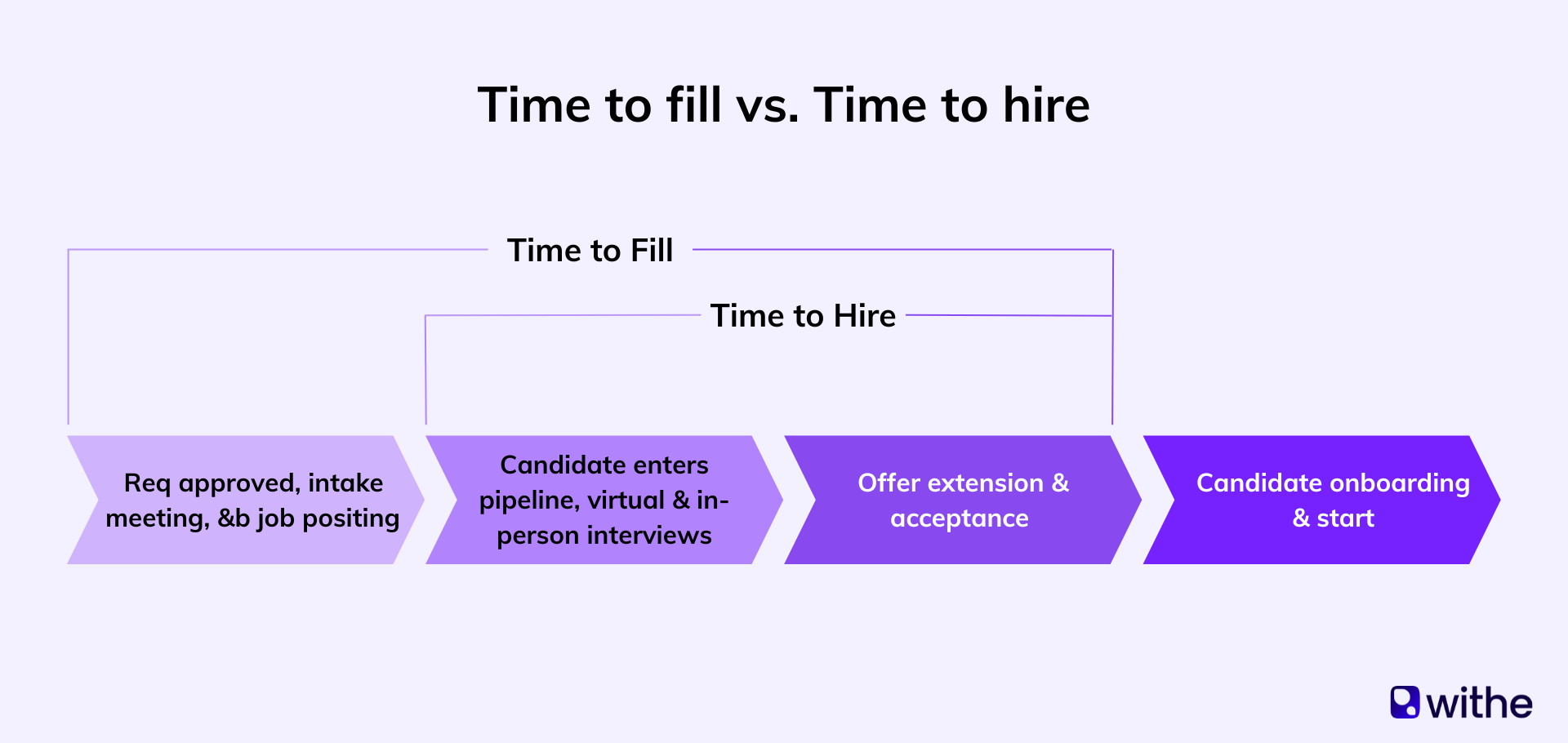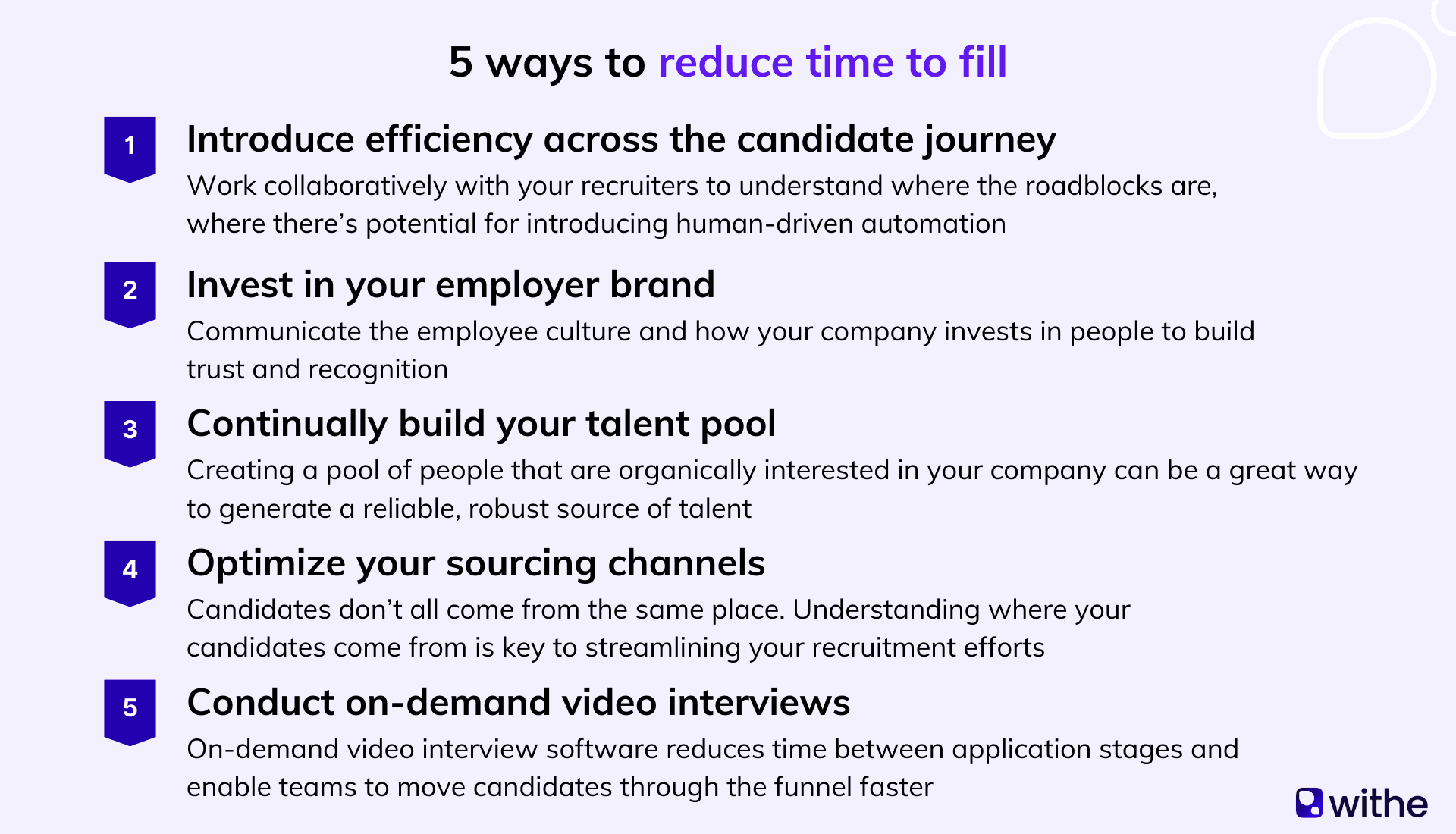Leverage Withe's hiring event platform
Streamline your seasonal and high-volume hiring process and hit your hiring targets.
We talk often about how hiring is an inherently human experience — and it is. At the end of the day, as a recruiter, you’re looking to make real connections with people to better identify that they’re the right fit for your role. Not only that, you know that the best employees are the ones that are happy in their roles, so ensuring the right fit is paramount.
That all said, recruitment is also a numbers game. There are a number of different metrics that evaluate the efficiency and effectiveness of a recruitment team, providing insights into performance and where they can do better. Today, these metrics are particularly important as companies are competing for the best talent, and they need to be able to move quickly to secure it.
One such metric is time to fill. Measuring the time between a job being posted and the role being filled, it’s one of the most important performance indicators for recruitment teams that want to be competitive in their industry. In fact, reducing time to fill has become a key goal for many teams.
In this blog post, we’ll spend some time defining time to fill and why it’s important, and also provide you with five strategies to help you improve on this metric.
Leverage Withe's hiring event platform
Streamline your seasonal and high-volume hiring process and hit your hiring targets.
What is time to fill?
Time to fill is a recruitment metric that measures the number of days between a job being posted and a candidate accepting an offer for that role.
How to calculate time to fill
Time to fill can be measured by counting the number of days between the job posting date and the role being filled. To measure an average time to fill rate, you would add up your time to fill figures and divide that by the number of jobs filled.

Why is measuring time to fill important?
Measuring time to fill can help you evaluate the efficiency of your team’s recruiting and hiring efforts, while also uncovering areas of improvement for streamlining processes, marketing your open positions, or optimizing the candidate experience.
Time to fill can also help you identify which types of roles are harder to fill, so you can invest more in the success of these hiring opportunities. Plus, once you have a consistent measurement for this metric, it can help you project the effort required for future hiring initiatives so you can better plan your budgets and resourcing.
While leveraging this metric is important for learning and strategizing, there’s also a lot of value in reducing time to fill where possible — here’s why. Increasing the speed of your recruitment team will help them be efficient and competitive in a hiring landscape that’s challenging at best. The truth is, today, hiring teams that are agile and fast are more likely to fill an empty role. And those that are burdened by cumbersome processes and legacy technology are bound to lag behind, filling roles with people that aren’t quite right, and increasing the risk of turnover as a result.
Time to fill vs. time to hire
The terms time to fill and time to hire are often used interchangeably, but they actually represent different data points. Whereas time to fill looks at the entire span of time between a job being approved for posting and it being filled by a successful candidate, time to hire takes a more narrow approach. It measures the amount of time between a candidate applying for a role and accepting an offer.
In both cases, the goal for recruiting teams is to reduce time to hire and time to fill as much as possible so that they can consistently hire high-quality candidates, quickly.
Let’s be clear: reaching your reduced time to fill target won’t be easy. It will require some investment, trial and error, and getting your team on the same page. To help you get there, here are four things you can do.

5 best practices to reduce time to fill
What follows are five best practices for lowering the time you spend filling open roles.
1. Introduce efficiency across the candidate journey
If your team is lagging behind where they should be with time to fill, it may be time to look for optimization opportunities across the candidate journey. Work collaboratively with your recruiters to understand where the roadblocks are, where there’s potential for introducing human-driven automation, and what help your team needs to move faster.
This is also a good opportunity to seek candidate feedback. They will be able to tell you where they felt the process lagged and where quicker touchpoints might have been possible.
Once you’ve identified areas of opportunity, prioritize them based on their potential impact and the level of investment required to make them happen. In this exercise, you’ll be able to quickly act on low-hanging fruit and create a roadmap for larger initiatives.
2. Invest in your employer brand
More and more, candidates want to know up front who they’ll be working for, what the company stands for, and what their overarching mandates are. They want a better sense of the employee culture and how the company invests in their people. This is where an employer brand comes in. If you communicate all these things often and transparently, you build trust and recognition. This means that by the time a candidate applies, they’re more likely to then accept an offer without hesitating.
Related resource: How to build a stronger employer brand to support your volume hiring efforts
3. Continually build your talent pool
Recruiting doesn’t only need to happen when you’re looking to fill a role. Creating a pool of people that are organically interested in your company can be a great way to create a reliable, robust source of talent that you can explore when you next have an available role. There are a couple of ways to supplement this candidate pool:
- Keep an open application on your site for anyone that might be interested in working with your company
- Develop a referral program where existing employees can recommend people that would be a good fit for the future
- Have a social presence for your employer brand where people can ask questions and put their hand up for future roles
At Withe, we’re helping seasonal and volume hiring teams reduce time to fill with our hiring event platform
4. Optimize your use of sourcing channels
Understanding where your candidates come from is key to streamlining your recruitment efforts. Start by extending your reach across multiple sourcing channels — not just job boards but via social media and channel partnerships as well — and identify which of these perform best for different roles or levels of experience. Say you find out that the best channel for hiring marketers is through a social media partner. The next time you have to hire for this department, you can save time by investing more in this particular channel.
5. Conduct on-demand video interviews
A big component in reducing time to fill is being able to create relationships with candidates quickly. A lot of the time, this comes down to having a real conversation between a candidate and a recruiter so that a) the recruiter can get a better sense of whether this person is a good fit and b) the candidate can learn more about the role and establish more trust in the company.
On-demand video interview software can enable teams to have these virtual conversations quickly. The added benefit? These real conversations are bound to make candidates more likely to accept an offer down the line — especially in high-volume hiring situations.

Expand your perspective
Reducing time to fill is an important goal, especially in this competitive recruitment landscape. However, it’s important to remember that it is just one of many metrics that evaluate your team’s performance. Looking at it alongside other important metrics — like cost-per-hire or the offer acceptance rate — will help you create the best possible strategy for moving forward.
We’re helping high-volume hiring teams reach their time to fill targets. Learn how on our home page.




